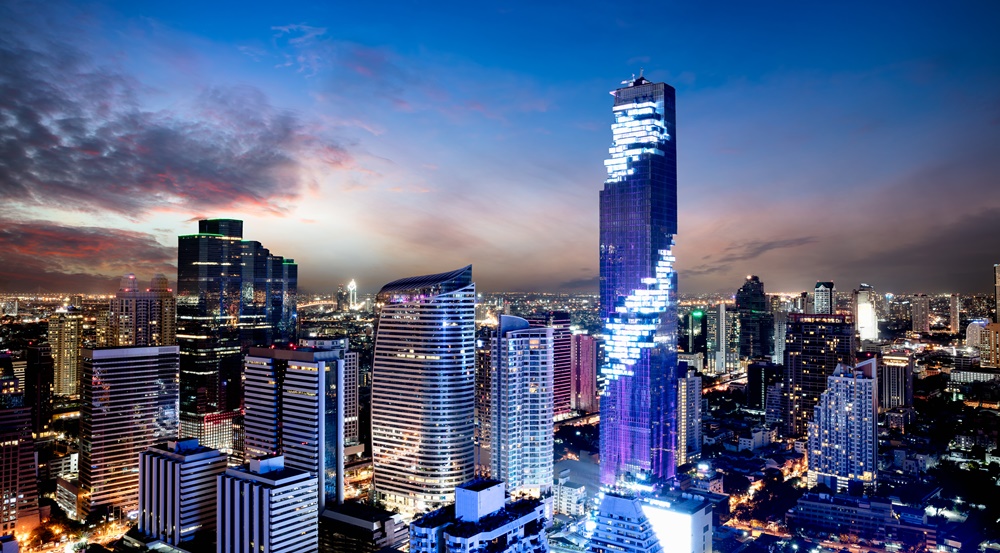Mr. Marcus Burtenshaw, Executive Director, Head of Occupier Services & Commercial Agency, Knight Frank Thailand said that “As rental growth continues its upward cycle, tenants are encouraged to review their accommodation strategy as we head into unchartered waters. Where Bangkok was once one of the cheapest office markets in the world, today that is no longer the case, with grade A rents in Bangkok comparable to cities like Madrid and even Chicago.”
Office Market Indicators

Economic Overview
The Thai economy was relatively weak throughout the first 3 quarters of 2019, expanding at the slowest pace over the past 5 years. GDP in Q2 2019 grew by 2.3%Y-o-Y, down from the 2.8% expansion recorded in the first quarter.
The economic slowdown was driven by declines in both domestic demand and external factors. In Q2 2019, private and government final consumption expenditure both increased, but at a considerably slower pace than last year. Flooding in the North and Northeast negatively impacted domestic consumption. Meanwhile, export competitiveness has been dampened as a result of the US-Sino trade dispute, and the strengthening of the Thai baht against the US dollar at a faster rate than its trade competitors in Asia. In an effort to combat the economic slowdown, the government is rolling out a 316 billion baht stimulus aimed at boosting economic growth by 0.5% to 0.6% in 2019.
Supply
According to Knight Frank Thailand Research, In Q3 2019, the total supply of office space in Bangkok increased by 49,800 square metres to a total of 5,125,617 square metres. Total supply increased by 1% Q-o-Q and 1.6% Y-o-Y. One new building increased supply of office space in the CBD by 45,000 square metres. Notably, this is the first supply addition to the CBD since Q3 2017. There were no withdrawals of obsolete stock in this quarter. Over the past 5 years, net supply has been growing at a rate of 24,418 square metres quarterly.
Figure 1
Bangkok Office Supply

Future Supply
Looking forward at the development pipeline, 5 more buildings are expected to be completed in Q4 2019, adding 127,404 square metres of office space to the market. All 4 buildings will be located outside of the CBD. However, the economic slowdown and lowered demand level may encourage some developers to delay project delivery to the following year.
From Q4 2019 to 2023, the Bangkok office market is projected to grow by 1,171,829 square metres or an average of 275,724 square metres annually (accounting for only additions and not withdrawals). In comparison, from 2015 to Q3 2019, new supply entered the market at a rate of 139,385 square metres annually. By the end of 2023, total office market supply will likely exceed 6 million square metres.
Table 1
Bangkok Office Future Supply

Given the new property tax amendment commencing in 2020, a greater volume of stock withdrawals is anticipated to occur gradually. For commercial properties, the amendment will introduce a marginal tax rate from 0.3% to a maximum of 1.2% on government-appraised value. It will replace the current household and land tax that charges 12.5% on the annual rental value. The new tax will place a heavier burden on low grade or poorly performing properties that are located in prime areas. It may incentivize the landlords of such properties to make capital improvements to their buildings.
Table 2
Bangkok Office Future Supply (Projects)

Demand
Leasing activity in Q3 2019 was slightly subdued, as take up declined to 51,485 square metres from 68,987 square metres in the previous quarter. This represents an 8% quarterly decrease, which puts the take up level below the 10-year quarterly average of 64,406 square metres. This is the first time Q3 take up has fallen below 40,000 square metres since 2013. Take up of new and refurbished space only accounted for around 41% of this quarter’s total, down 10% Q-o-Q. Over the past few years, tenants have shown a preference for higher quality buildings that offer a better experience. Newer and refurbished buildings tend to meet this criteria and can often attract a high level of demand. However, worsened economic conditions may have caused some current and potential tenants to adopt a ‘wait and see’ approach on any office relocation or expansion plans that they may have.
Figure 2
Bangkok Office Quarterly Take Up

Positive net absorption increased total occupied space by 20,138 square meters to a total of 4,650,635 square meters. Net absorption increased from 11,990 square meters recorded in the previous quarter, and is also significantly higher Y-o-Y as total occupied space declined by 19,509 square meters in Q3 2018. However, over the past 12 months, total supply increased by 80,000 square meters while total occupied space increased by only 26,271 square meters. The mismatch suggests that annual demand was much lower than supply over the past year.
Figure 3
Bangkok Office Supply – Demand Dynamics

The increase in supply was unmatched by net absorption. This has caused the market occupancy rate to drop to 90.7% from 91.2% in the previous quarter. Despite the decrease, the occupancy rate is still above the 10-year average of 89.8%, indicating that there is still a relatively good level of stability in the market. Occupancy levels declined for both grade A and B buildings, falling by 3.0% and 0.5% from the previous quarter, respectively. On the other hand, the grade C occupancy rate increased by 0.4% to 87.7%. In the CBD, the largest increase in occupancy occurred along Wireless Road, which increased by 0.4% Q-o-Q and 0.9% Y-o-Y to 91.8%. In contrast, occupancy in the Silom – Sathorn area declined by 0.5% Q-o-Q and 1.65 Y-o-Y to 92.6%. Outside the CBD, the occupancy rate increased the most in Bangna, having increased by 1.2% to 85.5%.
Figure 4
Bangkok Office Supply, Demand and Occupancy Rate

Table 3
Bangkok Office Occupancy Rate By Grade

Rental Rates
Average asking rent increased by 1.2% to 789 baht per square metre per month, demonstrating some resilience to current economic conditions. The introduction of new supply that is priced in the grade A
range is likely a contributing factor to the rising rent level. Over the past 5 years, rent has been increasing at an average of 5.0% annually. In Q3, only the average asking rent for grade B buildings increased. The rent for this segment increased by 0.9% Q-o-Q and 5.4% Y-o-Y to 819 baht. Meanwhile, the grade A asking rent has been stagnating over the past six months. Despite being up 8.8% Y-o-Y, the asking rent dropped to 1,129 baht, representing a second consecutive quarter of decline.
Figure 5
Bangkok Office Average Asking Rent by Grade

Rent By Areas
Office buildings in the CBD areas sampled displayed an increase in rental rates over the past quarter, except for those in Asoke – Phrompong. In addition to commanding the highest rents, office buildings along Wireless Road experienced the highest rental increase. The asking rent increased by 4.1% Q-o-Q and 10.1% Y-o-Y to 1,148 baht. Outside of the CBD, rents increased the most for Paholyothin – Viphavadi, increasing by 5.1% from the previous quarter to 760 baht. In contrast, rents in Asoke – Petchburi declined by 1.6% to 818 baht, but are still up 4.1% Y-o-Y.
Table 5
Bangkok Office Sub-Market Indicators

Outlook
In Q4, net absorption will most likely still be positive, albeit at a subdued level. Although there is still room for growth, the market appears to be approaching the end of an expansionary period. It is likely that the current economic slowdown will stretch into 2020, and this will impact future plans for both landlords and tenants. There is a possibility that developers will delay project handover while anticipating stronger demand in later years. Asking rents are projected to continue rising, but may do so at a slower pace as tenant bargaining power grows with the increasing options of high quality workspaces.














